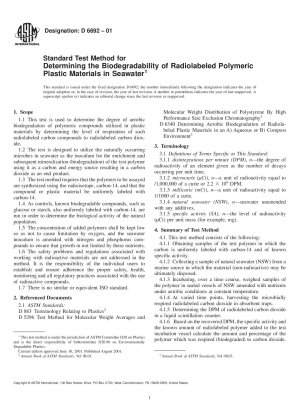ASTM D6692-01
Standard Test Method for Determining the Biodegradability of Radiolabeled Polymeric Plastic Materials in Seawater
- Standard No.
- ASTM D6692-01
- Release Date
- 2001
- Published By
- American Society for Testing and Materials (ASTM)
- Status
- 2010-02
- Latest
- ASTM D6692-01
- Scope
This method allows for a definitive determination concerning aerobic microbial biodegradation occurring for plastic compounds of known uniform composition or of component materials used in the production of non-uniform (that is, blend) plastics.
The use of radioactive 14C materials eliminates the possibility of carbon dioxide measurement from anything other than the parent compound in question.
The use of this assay relies on the enrichment and growth of naturally occurring microbes in marine samples to biodegrade the radiolabeled plastic compounds generating cell material and carbon dioxide as the radiolabeled end products.
Time course (several days to several weeks) measurements allows for a biodegradation rate determination to be made, but caution should be exercised in extrapolating this laboratory determined rate to what may actually occur in an open system marine environment which may experience fluctuations in nutrient availability, oxygen and temperature.
It may be necessary to repeat this test more than once (depending on the season of water sampling) since microbial populations vary significantly over time and location.
The seawater inoculum may be run with a sample (k 10 gram quantities) of marine sediment added to the seawater inoculum to increase the microbial diversity in establishing an enrichment capable of biodegrading the polymer being tested.
1.1 This test is used to determine the degree of aerobic biodegradation of polymeric compounds utilized in plastic materials by determining the level of respiration of such radiolabeled carbon compounds to radiolabeled carbon dioxide.
1.2 The test is designed to utilize the naturally occurring microbes in seawater as the inoculum for the enrichment and subsequent mineralization (biodegradation) of the test polymer using it as a carbon and energy source resulting in a carbon dioxide as an end product.
1.3 The test method requires that the polymers to be assayed are synthesized using the radioisotope, carbon-14, and that the compound or plastic material be uniformly labeled with carbon-14.
1.4 As controls, known biodegradable compounds, such as glucose or starch, also uniformly labeled with carbon-14, are run in order to determine the biological activity of the natural population.
1.5 The concentration of added polymers shall be kept low so as not to cause limitation by oxygen, and the seawater inoculum is amended with nitrogen and phosphorus compounds to ensure that growth in not limited by these nutrients.
1.6 The safety problems and regulations associated with working with radioactive materials are not addressed in the method. It is the responsibility of the individual users to establish and ensure adherence the proper safety, health, monitoring and all regulatory practices associated with the use of radioactive compounds.
1.7 There is no similar or equivalent ISO standard.
ASTM D6692-01 Referenced Document
- ASTM D5296 Standard Test Method for Molecular Weight Averages and Molecular Weight Distribution of Polystyrene by High Performance Size-Exclusion Chromatography
- ASTM D6340 Standard Test Methods for Determining Aerobic Biodegradation of Radiolabeled Plastic Materials in an Aqueous or Compost Environment
- ASTM D883 Standard Terminology Relating to Plastics
ASTM D6692-01 history
- 2001 ASTM D6692-01 Standard Test Method for Determining the Biodegradability of Radiolabeled Polymeric Plastic Materials in Seawater
